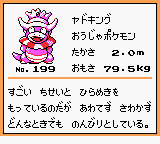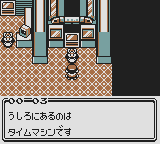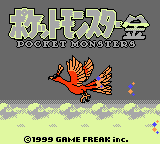🎊 Happy 2025, TCRF! 🎊
Prerelease:Pokémon Gold and Silver/Late Development
This is a sub-page of Prerelease:Pokémon Gold and Silver.
March
Gold and Silver finally resurfaced in the April 1999 issue of CoroCoro, with the magazine revealing that the games were now being developed for the Game Boy Color. In the games' coverage, new Pokémon and characters are reintroduced, along with the rewritten plot and a new batch of screenshots. Notably, the screenshots reveal that the gender symbols had not yet been implemented on the battle screens.[1]
| Early '99 Build | Final Game |
|---|---|
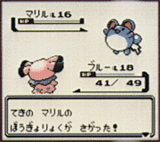 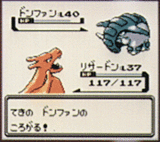 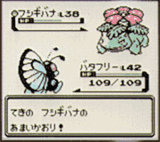
|
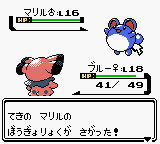 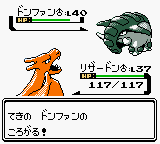 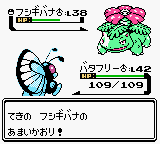
|
This Venusaur has the Poké Ball indicator beside its name, indicating that it's a wild Pokémon the player already caught. Given how nonsensical it would make to have a fully evolved starter Pokémon be a wild Pokémon, it's likely this Venusaur was programmed in as to give the readers a familiar face in one of the battle scenes. To no surprise, in the final games, Venusaur cannot be found in the wild.
Also worth noting is Snubbull's early backsprite, which appears to be in a transitional stage between its Spaceworld '97 and final iterations.
| Early '99 Build | Final Game |
|---|---|

|

|
The player fighting against Picnicker Kanami ("Kim" in the international version), who can be found on Route 35 in the final games. The trainer class Picnicker (ピクニックガール, Picnic Girl), known in Gen I as Jr. Trainer (ガールスカウト, Girl Scout), was not yet renamed. It's also worth noting that this trainer is shown having two Pokémon here, while in the final games she only has one.
Interestingly, in the Space World '99 demo, Picnicker Kim and Picnicker Brooke's names are swapped, meaning that Kim has a Pikachu while Brooke has a Vulpix. Moreover, in this demo, Kim has three Pikachu instead of just one, so it can be assumed that, in the earlier build featured in this screenshot, Kim had two Pikachu.
| Space World '97 Proto | Early '99 Build | Space World '99 (Caught Pokémon) | Final Game |
|---|---|---|---|
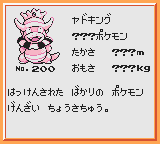
|

|
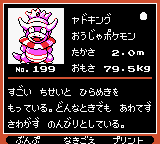
|
This screenshot of Slowking's Pokédex entry reveals quite a few differences in layout remain:
- The "new Pokémon under investigation" placeholder entry remains from the Space World '97 Demo, where it was used for every new Pokémon that lacked proper data.
- Like in the Spaceworld '97 Demo, the Pokémon sprite shown in their Pokédex entry was flipped horizontally, a carryover over from Generation I. In the final games, and every subsequent game, sprites in the Pokédex are displayed exactly how they are in battle and on the status screens.
- There is no red border between the basic infobox and the description
- This build still lacks sub-menu options, like Page, Cry, or Area.
- The Pokédex number is missing.
- The border around the screen is a plain apricot colored bevel, as opposed to the dark red line with white highlights used in both later builds and the final games.
- Both the Spaceworld '99 and Silver demos use the final Pokédex layout, but when you catch a Pokémon it uses a modified version of the Spaceworld '97 layout instead.
April
- Pokémon Pinball is released, featuring two tracks that share their melodies with songs in Gold and Silver, namely Blue Field for Ecruteak City and Cianwood City, and the high score entry screen for the credits of Gold and Silver, respectively. Gō Ichinose composed the soundtrack of Pokémon Pinball as well as a majority of the Gold and Silver soundtrack, including the two aforementioned tracks, and used the melodies for both games.
- Nintendo's official page for the games gets a complete overhaul to reflect the progress in development, showing some new artwork and screenshots, and the finalized logos for Pocket Monsters: Gold and Pocket Monsters: Silver.
- Coverage of the games continues in the May 1999 issue of CoroCoro, where it is revealed that the games are slated for a June release that would end up being pushed to mid-November. Promotional material for Pikachu's Rescue Adventure is also shown, revealing the finalized design for Hoothoot and Elekid, two Pokémon who made their debut appearance in this short.[2]
Some screenshots of the game's overworld are also provided, the multicolored screens indicating that the games had been fully ported to the Game Boy Color (clearer version of those screenshots were posted on Nintendo's official Gold and Silver page in May). Interestingly, the protagonist is seen using his early overworld sprites from the Spaceworld '97 demo, said sprites still being present in the final game, albeit going unused. Speaking of overworld sprites, it's also worth noting that, much like in the Spaceworld '97 prototype, they aren't offset in this build, and as such perfectly align with the overworld tiles.
Screenshots of the game are provided, using multicolored palettes that prove the games had been fully ported to the Game Boy Color. Clearer versions of these screenshots were later posted on Nintendo's official Golden and Silver page in May.
Notably, the protagonist is still using the overworld sprites from the Spaceworld '97 demo, and these sprites remain, unused, in the final game. They also aren't offset, and align perfectly with the overworld's tiles.
| Early '99 Build | Final Game |
|---|---|
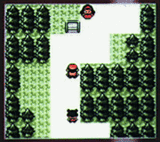
|
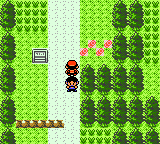
|
This appears to be Route 30, which has a slightly altered layout.
- The story progress blocking ledge is missing in this build, suggesting that the Youngster battle was added later in development.
- The different main path suggests that the branch, leading to Mr. Pokemon's House, didn't exist in this build.
- The two female NPCs in this picture were replaced by a Youngster and a female Cooltrainer NPC in the final game.
| Early '99 Build | Final Game |
|---|---|

|
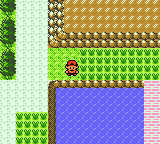
|
This route, which appears to be Route 32, also shows a few differences.
- The prerelease has an awkward placement for the bridge, which was fixed in the final by making the water's edge completely straight.
- The water tiles are also lifted from Generation I.
| Early '99 Build | Final Game |
|---|---|

|
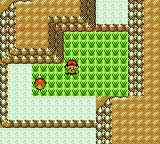
|
This early version of Route 45, which was later found in leaked material, features two main differences:
- There is only normal, short grass where there is a patch of tall grass in the final game, and the item ball is missing.
- Interestingly, the top left section of the corner mountain tile has an 8×8 tile of grass, which here is used to make the transition between grass and mountains smoother. In the final games, this tile was replaced by a rock tile, though the "modern" Johto blockset- namely, the one used by Goldenrod City- wasn't updated, and thus retained this grass tile.
| Spaceworld '97 Proto | Early '99 Build | Spaceworld '99 Proto | Final Game |
|---|---|---|---|

|

|
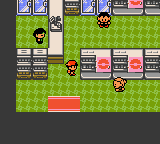
|
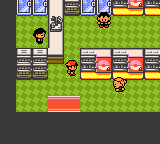
|
This screenshot of Violet City's Poké Mart, while having some slight NPC placement differences, namely showcases differences with the map itself:
- Although the layout is somewhat similar to the final games, the tileset still resembles the one from the Spaceworld '97 demo, and was completely redrawn later.
- The counter's color was changed from red to white, and the case sitting on it was removed.
- The freezers were moved from sitting in front of the back wall to being embedded inside of it.
- Both the cooler in the lower-left and foreground shelves in the lower-right were removed.
- Interestingly, while by the Spaceworld '99 demo the mart tileset was pretty much finalized, the cash registers faced a different direction. This was likely done when working on the Department Store maps, prior to being reverted in the final games.
Nintendo Promotional Video
A promo video which was showcased at the Spaceworld '99 event in August,[3], with higher quality stills from this video used in issue 124 of Electronic Gaming Monthly US.[4]
The build of the game shown in this video appears to be a much earlier build than the one shown at Spaceworld '99, evidenced by it using earlier tilesets, and the shiny Bellossom sprite instead of its regular sprite. We can infer that this build must be right before May 1999, because after this date the final water tiles are used instead of the Generation I games.
Regardless, the game heavily resembles the final game, with these differences present:
- Ho-Oh on the title screen has its original dark purple palette, although it is difficult to see.[5]
- Some of the wild Pokémon encounters are impossible to encounter in the final games, namely Slowking, Ampharos and Togepi. It's likely they were placed so they can demonstrate the new monsters for the press.
- Speaking of Slowking, it is seen here using an early backsprite, which can be seen in the June 13, 1999 sprite bank. The final sprite only starts appearing in the June 21st sprite bank.
| Early '99 Build | Final Game |
|---|---|
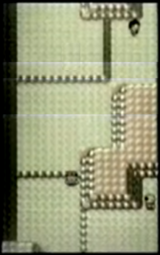
|
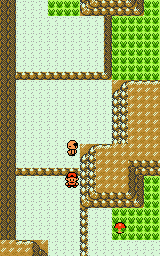
|
This early version of Route 45 is not only covered in plain grass, but still features some differences:
- The tall grass patches that are sprinkled along this road in the final games are missing here.
- The Hiker NPC was on the right side of the path in this build of the game.
- A Cooltrainer NPC can be seen near one of the top ledges, but is missing in the final games.
- The item ball on the ledge is missing.
| Early '99 Build | Final Game |
|---|---|

|
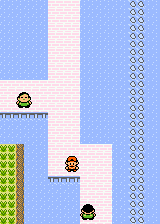
|
Another early shot of Route 32, with its own share of differences:
- The Generation I water tiles return.
- The bridge has a different layout, and appears to be longer than in the final games, with no dry land to be seen.
- The NPC placement is different, with the top Fisherman facing a different direction.
| Early '99 Build | Final Game |
|---|---|

|
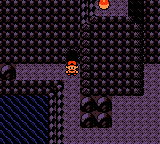
|
This shot of the Mt. Mortar shows differences with how darkened caves worked. Namely, the player's surroundings are faintly seen, which is identical to how unlit caves worked in Generation I. In comparison, Generation II made it so that they are pitch black until Flash is used. As a side note, the item ball on top of the rock formation is also missing, which isn't surprising, as it wasn't originally placed there. The Blackbelt Kiyo sat in this spot, instead, in the Spaceworld '99 demo.
| Early '99 Build | Final Game |
|---|---|

|
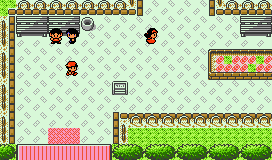
|
A quick glimpse of the National Park, with its differences including:
- The entrance carpet instead appears to be made out of bricks, although it's very hard to see in the faded footage.
- The trash can by the benches is missing.
- The brown brick tiles were redrawn to be larger and rounder, and the front-facing fences were made shorter, and the side-facing ones were completely changed.
- The border brick tiles are smaller and thinner than in the final game, and the decorative loop edging along the border brick are larger here than they are in the final game.
- The fence block which makes a connecting corner, here in the top left, doesn't exist yet.
- While hard to notice, the tree graphics are rougher, which can be seen in the leaked original National Park tileset.
- Similarly, the tree graphics are in an earlier state, which is also seen in the leaked original National Park tileset.
- NPC placement is completely different. The Youngsters by the benches aren't there, with a Rocker and Fisher NPC in their place. The female NPC is missing entirely.
| Early '99 Build | Final Game |
|---|---|

|
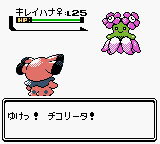
|
The normal Bellosom design appears to use its shiny sprite, with a blue body, rather than the green normal sprite of the final game. It's likely this was its original design, before being moved to be its shiny coloration in the final game. In contrast, by the time the Spaceworld '99 demo was compiled, the final color scheme is already in use.
CoroCoro Magazine - August Issue
The August issue of CoroCoro went on to not only introduce Murkrow's final design, but also shows the updated design of the PokéGear.[6]
| Early '99 Build | Final Game |
|---|---|

|
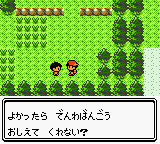
|
- Route 31's path is straight, shortening the route.
- The ledge is impassable, meaning you'd have to use Cut or walk through the grass in order to reach the upper half of the route.
- The Cuttable tree is further down than the final games' placement.
| Early '99 Build | Final Game |
|---|---|
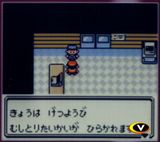
|
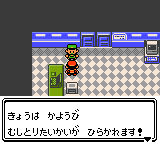
|
There are quite a few differences in this screenshot:
- The player is entering a Bug Catching Contest on a Monday. In the final, the contest is only held every Tuesday, Thursday, and Saturday.
- The Guard is given a blue palette, not a green one.
Also, the Gate House tileset is different:
- There is a brown striped back wall borrowed from the Trainer School.
- The counter is brown, not green.
- The shadow tile is blue instead of grey.
- The sign on the wall is in a rougher state, looking like the sign from the House tileset.
- The notepad by the laptop is missing.
- The door uses an edited door sprite from Spaceworld 97.
- There are no seats.
| Early '99 Build | Final Game |
|---|---|
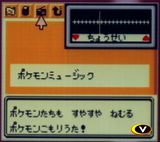
|

|
- The PokéGear's UI was redesigned, putting the Back button on the left side, and not the right.
- Number markers were added to the radio tuner.
- The phone icon was changed to a Candybar cell phone design, instead of a bulkier design.
- The "tuning" text was changed from ちょうせい to チューニング.
| Early '99 Build | Final Game |
|---|---|
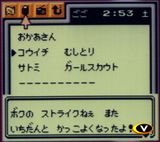
|
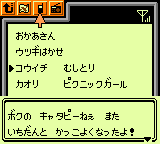
|
- The current time is seen in the top-right corner. In the final game, it's only displayed on the default home menu.
- Professor Elm is not present in the contact list.
- Bug Catcher Wade speaks of his Scyther, but he doesn't have one in the final.
- The Picnicker (ピクニックガール, Picnic Girl) class is still known as Jr. Trainer (ガールスカウト, Girl Scout).
- Furthermore, Picnicker Cindy (サトミ, Satomi) doesn't give you her phone number in the final games.
| Early '99 Build | Final Game |
|---|---|

|
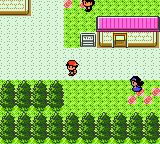
|
Shown in the November 1999 issue of Shogakukan Magazine are a few unobscured screenshots, that were shown in magazines published earlier that year.[7] Namely, this shot of Cherrygrove City shows that one of the female NPCs was moved around, and that she originally used a red palette instead of a blue palette.
Also shown on the website Videogames.com, there are a handful of screenshots from the same batch as the ones previously described:
| Generation I | Spaceworld '97 Demo | Early '99 Build | Final (JP) |
|---|---|---|---|
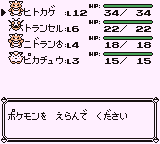
|
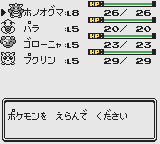
|
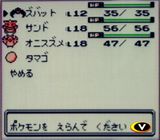
|
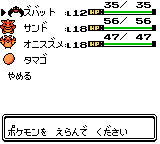
|
This screenshot shows an earlier iteration of the party layout, still in use.
| Early '99 Build | Final Game |
|---|---|
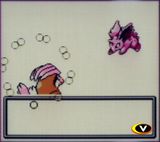 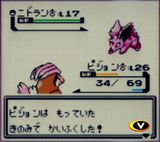
|
 
|
Two screenshots demonstrating Held Items. Unlike the final games, the status bar disappears as the healing animation plays.
| Spaceworld '97 Proto | Early '99 Build | Final Game |
|---|---|---|
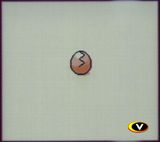
|
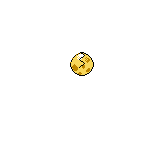
|
A hatching egg that uses an earlier design, that can be seen in the Spaceworld '97 demo. This sprite still exists in the SpaceWorld '99 demo, with a gray palette instead of tan, and is also the basis for the mini menu sprite in the final games.
CoroCoro Magazine - October Issue
The October issue of [8] contains a batch of screenshots, that had better quality copies appear later in the November 1999 issue of Shogakukan Magazine.[7]
| Early '99 Build | Final Game |
|---|---|

|
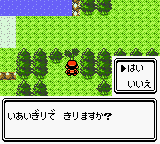
|
| Early '99 Build | Final Game |
|---|---|

|
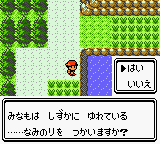
|
The Generation I water tiles is seen yet again, though the map layouts themselves have been finalized.
| Early '99 Build | Final Game |
|---|---|

|
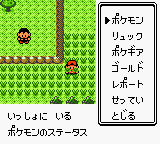
|
This build still lacks the Help text displayed across the bottom of the Start Menu screen.
| Early '99 Build | Final Game |
|---|---|

|

|
| Early '99 Build | Final Game |
|---|---|

|
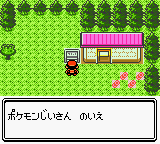
|
The sprite used for the Berry trees is different than the one used in the final games, here looking more like a standard tree. The sprite for said early tree was also found in the source code leak of 2020, and can be seen here.
| Early '99 Build | Final Game |
|---|---|

|
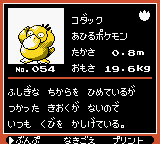
|
Psyduck's footprint appears to be longer and sharper here, compared to the final games' rounder footprint, bearing a greater resemblance to the footprint used for its evolution, Golduck.
| SpaceWorld '97 Proto | Early '99 Build | Final Game |
|---|---|---|

|
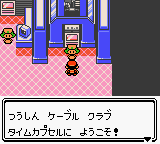
|
The receptionists found on the second floor of all Pokémon Centers are still using their sprite from the Spaceworld '97 demo.
| Early '99 Build | Final Game |
|---|---|
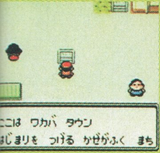
|
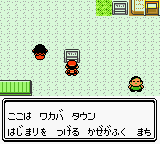
|
The Teacher NPC in New Bark Town is shifted one tile left, and the Technology NPC is assigned a blue palette instead of a green one.
| Early '99 Build | Final Game |
|---|---|
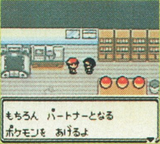
|

|
Professor Elm is using the sprite of a Gym Guide as a placeholder.
| Early '99 Build | Final Game |
|---|---|

|
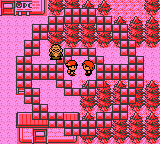
|
Around November 1999, a commercial for the games were made. There, a small clip from an earlier build of the game was spliced in, showing the early overworld player sprite.[9]
May
The June issue[10] of CoroCoro continued to reintroduce the games as well as new Pokémon, along with a series of screenshots that have some differences. Placeholder footprints can be seen on the Pokédex screens - a generic footprint with the dex number inside it. A few of these were not overwritten and are still located in the final games, visible in the dex entries for glitch Pokémon #252 to #256.
| Early '99 Build | Final Game |
|---|---|
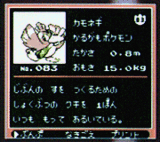
|
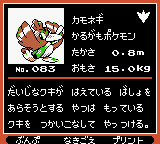
|
Farfetch'd uses its Pokédex entry from Red and Green.
| Early '99 Build | Final Game |
|---|---|

|

|
Clefairy uses its Pokédex entry from Blue.
| Early '99 Build | Final Game |
|---|---|

|
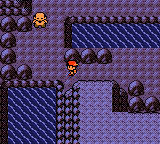
|
This map is most likely a section of Union Cave, but the layout is significantly different:
- The rock formation was seemingly replaced by a pool of water.
- The pool in the lower-left corner of the screen was lowered a bit more. Additionally, it lacks the shore tiles on both its right and left sides.
- Interestingly, this map uses the "day" palette instead of the "night" one. This then makes this cave resemble the basement of the Burned Tower, as well as the Mt. Silver summit, whereas in the final games all other caves have a dark purple tint.
| Early '99 Build | Final Game |
|---|---|

|
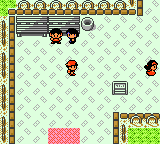
|
The area doesn't appear to have changed a lot when compared when compared to the SW99 promo video, though the two NPCs were moved around, and a brick floor tile was added to mark the exit from the National Park (in the final game these bricks were replaced by a rug.)
| Early '99 Build | Final Game |
|---|---|
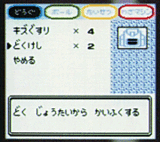 
|
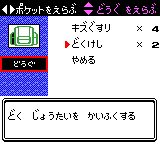 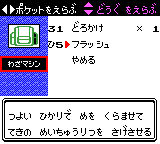
|
- The bar at the top of the screen is multicolored and shows every pocket in the bag, in addition to the one currently selected. The final games replaces this with a staid black bar that does nothing except show the menu's controls. Later Pokémon games would adopt a style similar to the early version.
- Since the navigation bar at the top was changed to show the controls, the name of the currently selected pocket was added beneath the bag.
- The entire menu switched its orientation, with the bag graphic being on the right originally, and the item list on the left.
- The menu has a light blue, patterned background instead of a dark blue one with less detail.
- The backpack's design was changed, with the cover for the large main pocket moved down, and the strap to open it removed.
- The regular items/medicine menu was moved from the small center pocket of the bag to the left pocket.
- As seen in the second screenshot, the left pocket was originally for TMs, while in the final games the right pocket is the one where TMs are stored.
June
The July issue[11] of CoroCoro introduces Lugia and its then-upcoming movie, all while also showing a few screenshots of Gold and Silver.
| Mid '99 Build | Final Game |
|---|---|
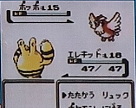
|
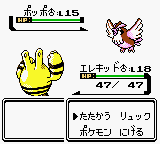
|
A fight between an Elekid and a Pidgey showing that the gender symbols were still not implemented.
| Mid '99 Build | Final Game |
|---|---|
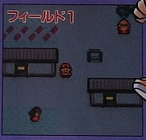
|
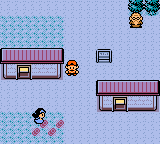
|
Interestingly, while Cherrygrove City’s layout here appears to have been finalized in a previous screenshot, it is different here, lacking one of the flower patches. It's then possible the devs tried to change the town's design slightly, only to then revert it back to its original design. As for the female NPC, she's still red instead of blue.
August
The September issue[12] of CoroCoro reveals a handful of screenshots, some of which also visible on a promotional flyer for Gold and Silver. Pokémon Gold and Silver were also showcased at Space World '99,[13] held at the end of August. The ROMs have since been acquired, and you can find the main article here. At the event itself, the game was playable at dedicated kiosks for 15 minutes, with the demo experience stopping at the Violet City gate.
The new features being presented at the event were an even more updated Pokédex, the Link Cable's backwards compatibility, and the Gameboy Printer's printing ability.[14] A contemporary IGN report states that the game was 90% complete, which matches with the build of the game that was later leaked. [15]
| Mid '99 Build | Final Game | Final Game (Palette Glitch) |
|---|---|---|
The title screen is very close to the final design, showing an animated Ho-Oh sprite flying through the skies. Unlike the final game, Ho-Oh's silhouette had visible highlights instead of a full silhouette. The decision to use full silhouettes had been made by the time of Space World '99. The extra detailing on the sprite is still present in the final game, but hidden by the color palette assigned to the sprite. By using a glitch that causes Ho-Oh to be displayed with an incorrect palette, the full details of the sprite can still be seen. Conversely, the Lugia that appears on the title screen of Silver lacks these extra palette colors, suggesting that version's title screen may have been created well after the developers decided to use full silhouettes, and that Lugia was added significantly later in the game's development.
The developers seem to have been really undecided with the idea of using a silhouette, as even the B-roll build from 1996 had Ho-Oh unobscured but then using a silhouette for the Space World '97 demo. To add insult to injury, even the games' remakes ended up scrapping the silhouette idea entirely.
References
- ↑ CoroCoro April 1999 - March 1999
- ↑ CoroCoro May 1999 - April 1999
- ↑ Game Catalog II's Spaceworld '99 News report.
- ↑ Electronic Gaming Monthly #124 - coverage is between P200-208
- ↑ IGN's screenshot section for Pokémon Gold and Silver.
- ↑ CoroCoro August 1999 - July 1999
- ↑ 7.0 7.1 Shogakukan Magazine - Scans By Twitter user @Zidapi.
- ↑ CoroCoro October 1999 - Sept. 1999
- ↑ Japanese commercial showing Gold with his early overworld sprites.
- ↑ CoroCoro June 1999 - May 1999
- ↑ CoroCoro July 1999 - June 1999
- ↑ CoroCoro September 1999 - Aug. 1999
- ↑ Spaceworld '99 Gold and Silver Coverage.
- ↑ Pokémon Gold and Silver IGN Coverage.
- ↑ Various Nintendo Space World 1999 Magazine Coverage.
